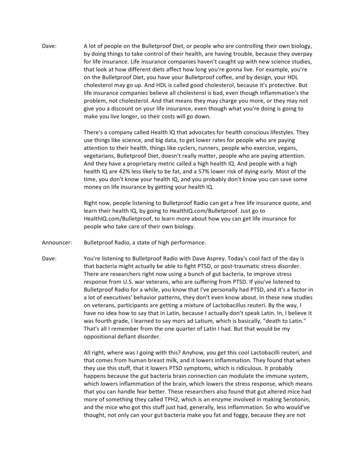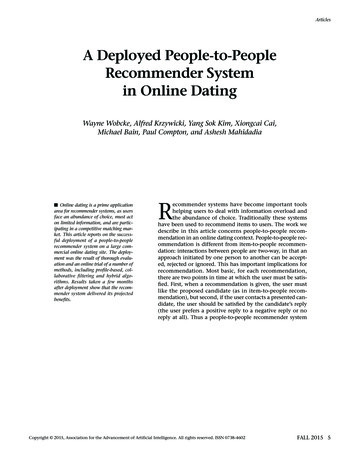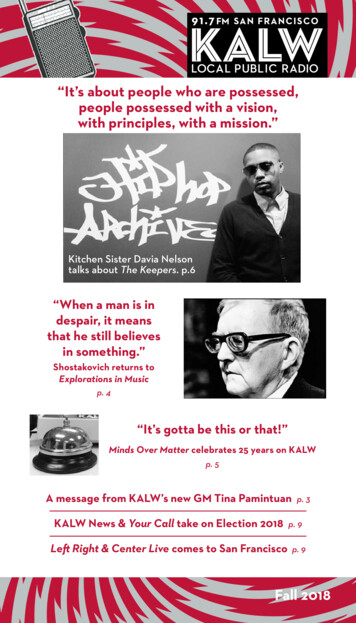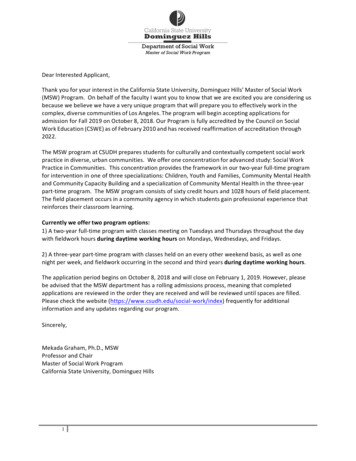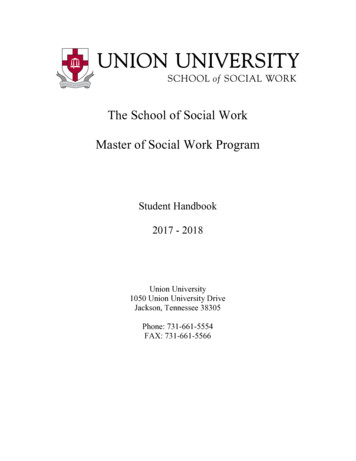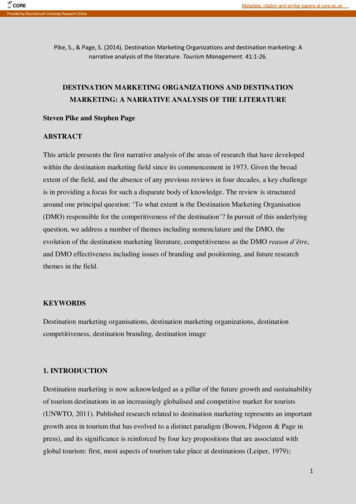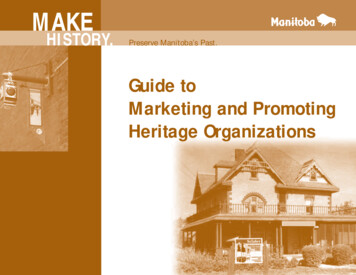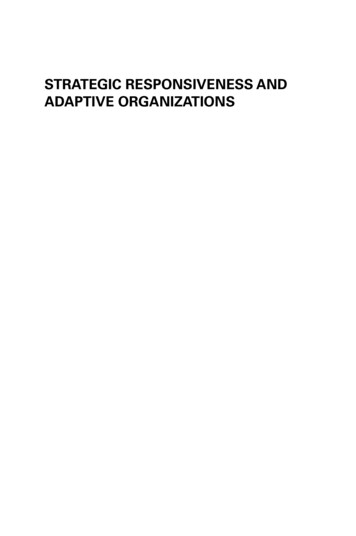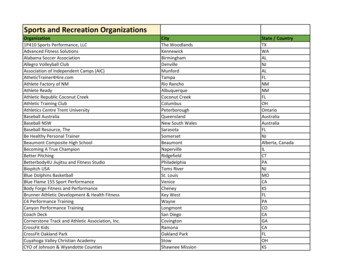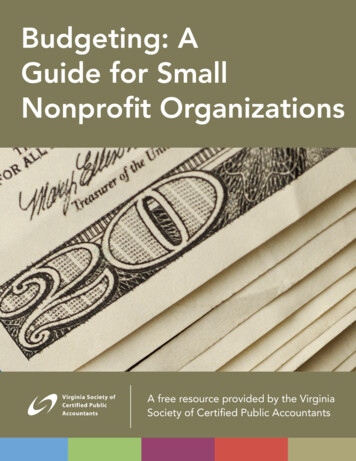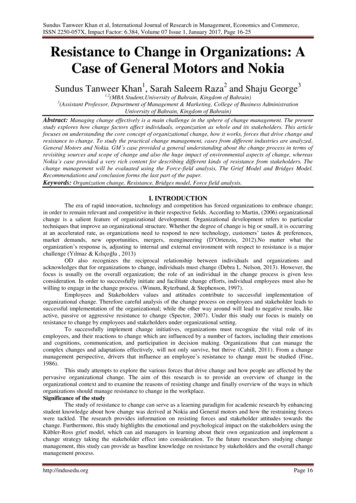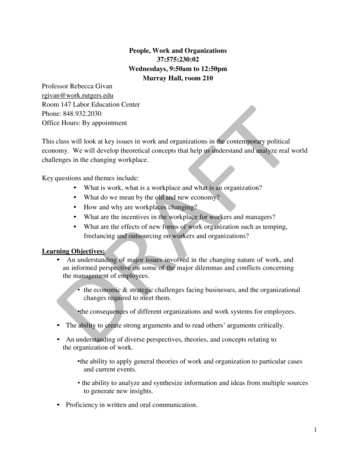
Transcription
People, Work and Organizations37:575:230:02Wednesdays, 9:50am to 12:50pmMurray Hall, room 210Professor Rebecca Givanrgivan@work.rutgers.eduRoom 147 Labor Education CenterPhone: 848.932.2030Office Hours: By appointmentThis class will look at key issues in work and organizations in the contemporary politicaleconomy. We will develop theoretical concepts that help us understand and analyze real worldchallenges in the changing workplace.Key questions and themes include: What is work, what is a workplace and what is an organization? What do we mean by the old and new economy? How and why are workplaces changing? What are the incentives in the workplace for workers and managers? What are the effects of new forms of work organization such as temping,freelancing and outsourcing on workers and organizations?Learning Objectives: An understanding of major issues involved in the changing nature of work, andan informed perspective on some of the major dilemmas and conflicts concerningthe management of employees. the economic & strategic challenges facing businesses, and the organizationalchanges required to meet them. the consequences of different organizations and work systems for employees. The ability to create strong arguments and to read others’ arguments critically. An understanding of diverse perspectives, theories, and concepts relating tothe organization of work. the ability to apply general theories of work and organization to particular casesand current events. the ability to analyze and synthesize information and ideas from multiple sourcesto generate new insights. Proficiency in written and oral communication.1
Books:There are no required books for this course. However, you will need to purchase a few casestudies (available for purchase online) for under 5 each, as detailed below. There is a Sakai sitefor the course, and readings will be posted there.Assignments: Note - you must complete all assignments to receive credit for the course.Participation (Includes attendance, thoughtful participation & all in-class work): 20%Exam 1 (February 22nd): 25%Exam 2: (April 26th) 25%Television assignment (February 8th): 5%Group presentation: 10%Case study paper (written individually, based on presentation due on Sakai May 2nd): 15%For all written assignments, please use 1” margins, double spacing and a 12-point font. Allpapers should be uploaded to Sakai.Academic Integrity:You are responsible for understanding and following the Rutgers University Policy on AcademicIntegrity. Information on the policy is available -integrity-at-rutgers/. Written assignments will besubmitted via Sakai and processed through Turnitin.Class schedule:The schedule of readings and assignments is below. We may need to move some topics (andreadings) to accommodate guest speakers. However, exam dates and assignment deadlines willnot change. You should complete all readings before class, and come to class ready to discusswhat you have read. In general, lectures will not repeat the material in the readings, but build onthis material, although you are encouraged to ask questions about the readings during class.There will occasionally be an assignment at the beginning of class (such as a quiz or shortwriting assignment) based on the week’s readings.Week 1 (January 18th):IntroductionsMovie (excerpts): Up in the Air (2009, 109 minutes)Week 2 (January 25th):What is work? Reich, R. B. (1992). The Work of Nations: Preparing Ourselves for 21st-CenturyCapitalism. New York, Vintage. pp 171-184.2
Schlosser, E. (2004). Reefer madness: Sex, drugs, and cheap labor in the American blackmarket, Mariner Books. Pp77-108.Stewart, M. (2006). "The management myth." Atlantic Monthly 297(5): 6/06/the-management-myth/4883/Week 3 (February 1st):What is an organization? Sorensen, J. “Note on Organizational Culture” Stanford Graduate School of Business,Case Study. Purchase online at http://cb.hbsp.harvard.edu/cb/product/OB69-PDF-ENG Nohria, Nitin “Note on Organizational Structure.” Purchase online athttp://cb.hbsp.harvard.edu/cb/web/product detail.seam?E 28242&R 491083-PDF-ENG Greenhouse, S. The Big Squeeze: Tough Times for the American Worker. New York:Knopf, 2008. Chapters 6 and 7 (pp. 98-134).Week 4 (February 8th)The “Old” Economy Drucker, P. F. (1992). "The New Society of Organizations." Harvard Business Review70(5): 95-105. Hochschild, Arlie Rusell. The Time Bind: When Work Becomes Home and HomeBecomes Work. New York, NY: Holt. 2000. Ch 5 (pp55-72).Television assignment due.Week 5 (February 15th):The “New” Economy Anon. The 21st-century organization - McKinsey Quarterly. Ross, Andrew. No Collar: The Humane Workplace and its Hidden Costs. New York:Basic Books, 2003. Chapters 2 (pp21-54) and 3 (55-86)Week 6 (February 22nd):Exam 1Week 7 (March 1st):Pay, performance and incentives Pfeffer, Jeffrey “Six Dangerous Myths about Pay” Harvard Business Review, May-June1998. Available online for purchase at:http://cb.hbsp.harvard.edu/cb/web/product detail.seam?E 61003&R 98309-PDFENG&conversationId 91652 Chambers et al. “The War for Talent” McKinsey Quarterly, 1998, Number 3. Eichenwald, Kurt (2012) “Microsoft’s Lost Decade” Vanity Fair, August rosoft-lost-mojo-steve-ballmer.print3
Week 8 (March 8th):Managing the global supply chain Struna, Jason et al. “Unsafe and Unfair: Labor Conditions in the WarehouseIndustry” Policy Matters, Volume 5, Issue 2. Summer 5-2-warehouse.pdf “China and the End of Cheap Fashion” (Chapter 7) in Cline, E. L. (2012). Overdressed:the shockingly high cost of cheap fashion. New York, Portfolio/Penguin.Spring BreakWeek 9 (March 22nd):Corporate Social Responsibility and anti-corporate campaigns Lenzer, Anna. “Fiji Water: Spin the Bottle” Mother Jones, September/October 2009. McMaster, James and Jan Nowak. “FIJI Water and Corporate Social Responsibility Green Makeover or "Greenwashing"?” Harvard Business School Case, 2011.Available for purchase online at:http://cb.hbsp.harvard.edu/cb/web/product detail.seam?E 1022151&R 909A08PDF- ENG&conversationId 75769 Friedman, Milton. “The Social Responsibility of Business is to Increase its Profits.” TheNew York Times Magazine, September 13, 1970.Week 10 (March 29th):The Unionized Workplace Zweig, Michael. The Working Class Majority: America’s Best Kept Secret,Second Edition. Ithaca: Cornell University Press, 2012. Chapter 6, “The WorkingClass and Power” pp117-142. Milkman, Ruth. “Two Worlds of Unionism: Women and the New Labor Movement”in Cobble, D.S., Ed. The Sex of Class: Women Transforming American Labor: Ithacaand New York: Cornell University Press, 2007. pp 63-80.Week 11 (April 5th):):Work without organizations: Gelles, David “At Zappos, Pushing Shoes and a Vision” New York Times, July 17 -zappos-selling-shoes-and-a-vision.html Horowitz et al: The Rise of the Freelance 2005/freelancers.pdfWeek 12 (April 12th):Group presentations4
Week 13 (April 19th):Group presentations and in class written assignment.Week 14 (April 26th):Exam 2Case study papers due May 1st (upload to Sakai).5
Television AssignmentYour assignment is to watch one episode of a one-hour reality/documentary (non-fiction)TV show that depicts a workplace and working relationships (do not choose a competitionshow). Watch the show and then write a 2-3 page response paper that does the following:1. Describe the workplace on the show in one paragraph.2. Discuss the representation of the workplace and workers in 1-2 paragraphs. What has theTV production chosen to emphasize. Does the representation promote or challenge anystereotypes?3. Highlight and discuss a particular issue in this workplace that relates to one ofthe concepts from this class. Issues might include: organizational culture;workplace hierarchy; job security; race and gender dynamics; recruitment andselection; job training; performance incentives. You should focus on only oneissue, describe the challenges and mention one or two suggestions for improvingthe workplace.You may choose any appropriate show, or select another show (you can get approval from mein class). Many of these shows are currently airing on TV, and most are also available onlinevia various websites including Hulu or for purchase from iTunes. Examples of possible showsinclude the following:Ice Road TruckersThe Deadliest CatchUndercover BossRamsey’s Kitchen NightmaresCoalAmerican ChopperDirty JobsLA/Miami InkBig Tips TexasThere are probably dozens of other shows that meet the criteria - choose one that interests you.6
Case study assignmentPresentation:You will be assigned a group, and as a group you will present a case study of an organization.The presentation should be 25 minutes long (please allow 5 minutes for questions) and shouldinclude a brief overview of the organization, and of one major challenge facing it. The remainderof the time should be divided between group members- each person should cover one of thefollowing areas:Organizational CultureRecruitment and selectionTrainingCompensationSupply chainLabor RelationsSustainabilityYou do not need to cover all of these areas- only those that are relevant to your assignedorganization. Your group must create slides for the presentation (using Powerpoint orequivalent). The slides should be clear and should highlight key points or examples from yourpresentation. The slides should be unified and the presentation should progress logically. Pleasepractice your presentation in advance, you may be penalized for exceeding the time limit.There is a very useful library guide (prepared by our fabulous librarian) which will help you withresearch for this assignment, available at http://libguides.rutgers.edu/peoplework. You should tryto use a variety of sources for your presentation and paper, and you may find useful informationon blogs, email lists, employee discussion boards. You might look at www.glassdoor.com forthis type of information (remember blogs and websites need to be cited, just like any othersource).Paper:Your (individual) case study paper will be about your individually assigned aspect of theorganization. You should write a 5 page paper about your aspect of the organization. This papershould include an overview of this aspect of the organization, and 2-3 critical suggestions forimprovement. You must write your paper on your own, and cite all of your sources.Organizations:Shake ShackAirBnBFacebookNissanAbercrombie and FitchTeslaChipotleIBM7
Murray Hall, room 210 Professor Rebecca Givan rgivan@work.rutgers.edu Room 147 Labor Education Center Phone: 848.932.2030 Office Hours: By appointment This class will look at key issues in work
